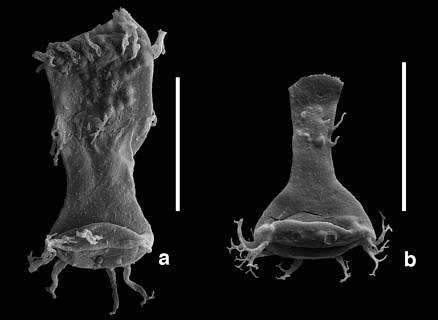Heavy metal poisoning led to mass extinction

FAU researchers have discovered that natural heavy metal poisoning led to an increase in deformities in plankton, causing a catastrophe
The dinosaurs were not the only creatures to become extinct – there have been other more dramatic events in the earth’s history after which large number of species disappeared. The reasons for this remain unclear. However, researchers from FAU have now discovered a previously unknown cause for mass extinctions. Severe naturally occurring heavy metal poisoning before an extinction event led to an increased level of deformities in certain organisms, which could be seen as the precursor to the catastrophe. The ground-breaking results of their study have recently been published in the journal Nature Communications.*
The debate as to whether the dinosaurs became extinct 65 million years ago as a result of an asteroid impact or as a consequence of climate change is still ongoing, as is the discussion of the role played by changes in sea level. Yet one thing is certain: mass extinction events have occurred again and again throughout the history of the earth.
If you turn back far enough through the pages of the earth’s history, back to the Palaeozoic Era, for example, you will find an extremely dramatic event. Around 450 million years ago, the second largest mass extinction in the planet’s history took place, an event during which half of all species disappeared from the earth forever. In addition, there were also many smaller extinction events during the Palaeozoic Era. The pattern of these smaller events is very similar to that of the second largest event, meaning they can be used to draw conclusions about what caused it.
Poisoned fossils
Now research by palaeontologist Prof. Dr. Axel Munnecke and palaeobiologist Wolfgang Kießling from GeoZentrum Nordbayern at FAU is shedding light on the subject. In collaboration with researchers from France and the USA, the FAU researchers carried out a geochemical analysis of 420 million-year-old sediments from Libya that date from the Silurian Period, with interesting results. ‘The microfossils contained in the core samples that were deposited at the beginning of the extinction event display not only a very high rate of deformed organisms but also high concentrations of toxic elements such as arsenic, lead and manganese,’ explains Prof. Axel Munnecke. Prof. Munnecke also has an explanation for how this poisoning occurred. ‘We suspect that toxic compounds were released from deep-sea sediments by what are known as oceanic anoxic events and transported to the flat shelves due to the spread of the resulting oxygen-free water where they led to an increased number of deformities in the organisms living there.’
Deformities as harbingers of a catastrophe
The heavy metal poisoning has severe consequences for organisms such as the minute zooplankton measuring a tenth of a millimetre that created the chitinozoa microfossils examined in the research – they developed numerous deformities. These findings allow the FAU researchers to join the dots. ‘One of the similarities between the mass extinctions in the Palaeozoic Era is that higher numbers of deformed organisms occurring at the beginning of these events are often observed worldwide,’ says Prof. Axel Munnecke. The same applies to the second biggest mass extinction event mentioned previously.
The researchers are therefore taking their hypothesis one step further. They believe that other mass extinctions could also have been triggered by naturally occurring heavy metal poisoning. This does not mean that the organisms were killed directly by heavy metal poisoning, but that increased levels of metals in the water of oceans started a complex chain of events that is not yet fully understood and which eventually led to mass extinctions. ‘If this is the case, the deformities were the harbingers of the catastrophe or, to put it another way, the canaries in the coal mine.’
*Thijs Vandenbroucke, Poul Emsbo, Axel Munnecke, Nicolas Nuns, Ludovic Duponchel, Kevin Lepot, Melesio Quijada, Florentin Paris, Thomas Servais, and Wolfgang Kiessling: Metal-Induced Malformations in Early Palaeozoic Plankton are Harbingers of Mass Extinction. Nature Communications: DOI: http://dx.doi.org/10.1038/ncomms8966
Weitere Informationen:
Pressestelle der FAU
Tel.: 09131/85-70218
presse@fau.de